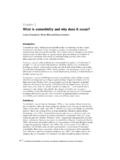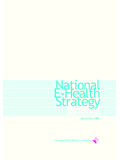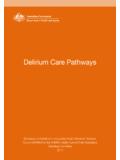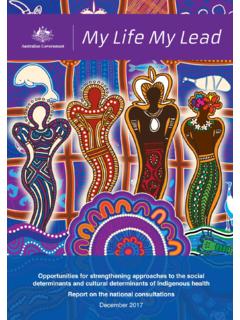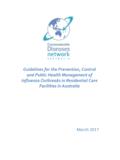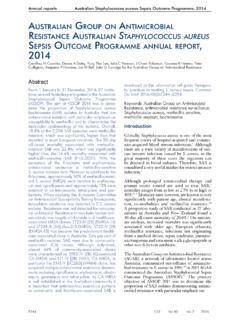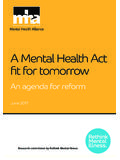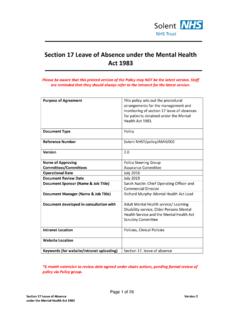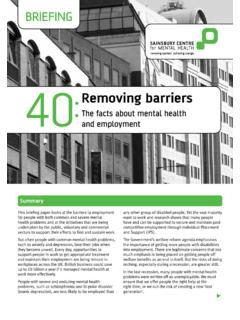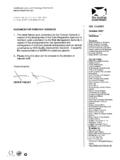Transcription of The Mental Health of Children and Adolescents - …
1 REPORT ON THE SECOND AUSTRALIAN CHILD AND ADOLESCENT SURVEY OF Mental Health AND WELLBEING2015 The Mental Health of Children and Adolescents The Mental Health of Children and Adolescents Report on the second Australian Child and Adolescent Survey of Mental Health and Wellbeing David Lawrence Sarah Johnson Jennifer Hafekost Katrina Boterhoven de Haan Michael Sawyer John Ainley Stephen R. Zubrick August 2015 ii The Mental Health of Children and Adolescents The Mental Health of Children and Adolescents . Report on the second Australian Child and Adolescent Survey of Mental Health and Wellbeing ISBN: 978-1-76007-187-5 Online ISBN: 978-1-76007-188-2 Publications approval number: 11097 Copyright Statements: Paper-based publications Commonwealth of Australia 2015 This work is copyright.
2 You may reproduce the whole or part of this work in unaltered form for your own personal use or, if you are part of an organisation, for internal use within your organisation, but only if you or your organisation do not use the reproduction for any commercial purpose and retain this copyright notice and all disclaimer notices as part of that reproduction. Apart from rights to use as permitted by the Copyright Act 1968 or allowed by this copyright notice, all other rights are reserved and you are not allowed to reproduce the whole or any part of this work in any way (electronic or otherwise) without first being given the specific written permission from the Commonwealth to do so. Requests and inquiries concerning reproduction and rights are to be sent to the Communication Branch, Department of Health , GPO Box 9848, Canberra ACT 2601, or via e-mail to Internet sites Commonwealth of Australia 2015 This work is copyright.
3 You may download, display, print and reproduce the whole or part of this work in unaltered form for your own personal use or, if you are part of an organisation, for internal use within your organisation, but only if you or your organisation do not use the reproduction for any commercial purpose and retain this copyright notice and all disclaimer notices as part of that reproduction. Apart from rights to use as permitted by the Copyright Act 1968 or allowed by this copyright notice, all other rights are reserved and you are not allowed to reproduce the whole or any part of this work in any way (electronic or otherwise) without first being given the specific written permission from the Commonwealth to do so.
4 Requests and inquiries concerning reproduction and rights are to be sent to the Communication Branch, Department of Health , GPO Box 9848, Canberra ACT 2601, or via e-mail to Suggested reference: Lawrence D, Johnson S, Hafekost J, Boterhoven De Haan K, Sawyer M, Ainley J, Zubrick SR (2015) The Mental Health of Children and Adolescents . Report on the second Australian Child and Adolescent Survey of Mental Health and Wellbeing. Department of Health , Canberra. The Mental Health of Children and Adolescents iii FOREWORD This report provides compelling reading for everyone interested in the Health and wellbeing of Australian Children and Adolescents . Based on a survey conducted in the homes of over 6,300 families with Children and/or Adolescents aged 4 to 17 years, the report presents a comprehensive picture of the Mental Health of young Australians.
5 It documents the prevalence and type of Mental Health problems, the impact of those problems on families and young people themselves and the role of Health and education services in providing assistance. While the primary sources of information were parents and carers, the survey also engaged directly with young people 11 years and older who completed their own survey. This information provides unique insights about aspects of their emotional lives and behaviour that are generally not visible to parents and carers. Australia has a proud tradition of undertaking Mental Health surveys of its population. Commencing in 1997 with the first household survey of the adult population, the National Survey of Mental Health and Wellbeing programme has produced six major surveys.
6 Two of these covered the more common Mental disorders in adults conducted in 1997 and 2007, two covered people living with less prevalent psychotic illnesses conducted in 1998 and 2010, and now with this report, two surveys have been undertaken of the Mental Health of Children and Adolescents . The first child and adolescent survey was conducted in 1998 and released in 2000. It was the first national survey of its type conducted anywhere in the world. The report on the second child and adolescent Mental Health survey presents a contemporary update on the next generation of Australian adults that is both reassuring and troubling. Overall prevalence of Mental disorders appears to be stable, with approximately one in seven Children and young people experiencing a Mental disorder in the past year.
7 This is consistent with comparable international studies. The most positive news is that access by families and young people to assistance appears to have increased substantially. The first survey found that only one third of Children and Adolescents aged 6-17 years with Mental disorders used services in 1998 in the previous six months. By contrast the second survey found just over two thirds were able to access services, although this was measured over a 12-month period. The vast majority (95%) used a Health service. Despite differences in methodology between the two surveys, the report notes that on balance the data points to a significant increase in service use by Children and Adolescents with Mental disorders in Australia between 1998 and 2014.
8 It is pleasing that the evidence from this more recent survey shows that those most in need have the best access to services. About nine out of every ten young people with a severe Mental disorder accessed assistance from the service systems provided by the Health and education sectors, as did about three quarters of those with problems of a moderate impact. This provides reassurance that the policies adopted by governments to lift the known low treatment rates for people with Mental illness are achieving results. The Australian Government in particular has had a special focus on improving both prevention and treatment efforts for young Australians, commencing with the introduction of the National Youth Mental Health Initiative in 2005 (now known as headspace).
9 More troubling is the range of information presented in this report that points to the need for refocussed effort by governments and the broader community to develop systems to both prevent Mental Health problems and to respond early to problems when they emerge. The rates for depression, self-harm and thoughts about suicide in teenagers are particularly worrying, with approximately one in ten indicating that they have engaged in self-harming behaviour. Three quarters did so in the previous 12 months. For iv The Mental Health of Children and Adolescents teenage girls aged 16-17 years, nearly one in five were found to meet the clinical criteria for depression based on their own report. Around one quarter of teenage girls in the 16-17 year age range reported deliberately injuring themselves at some point in their lives.
10 The rates for depression in 11-17 year olds were found to be higher when young people provided the information themselves ( ) than when their parents and carers did so ( ). This is an important signal to all parents who are faced with the challenging task of helping their Children navigate the transition from childhood to adulthood. Additionally, this survey has again highlighted the strong relationship between socioeconomic disadvantage and higher rates of Mental Health problems that has been found in comparable international studies. Children and Adolescents in low-income families, with parents and carers with lower levels of education and with higher levels of unemployment had higher rates of Mental disorders in the previous 12 months.
